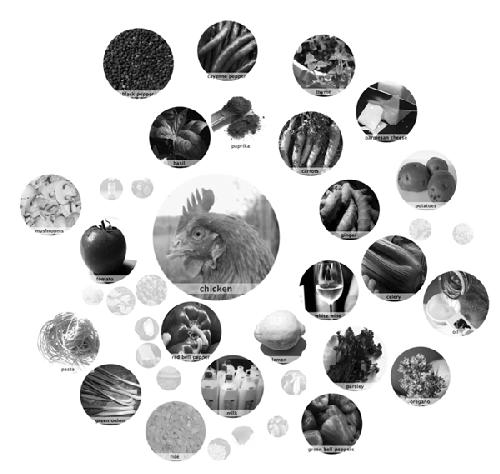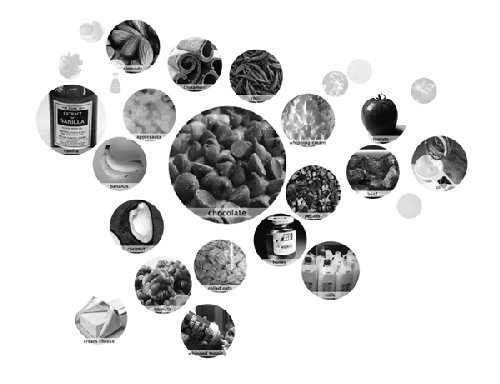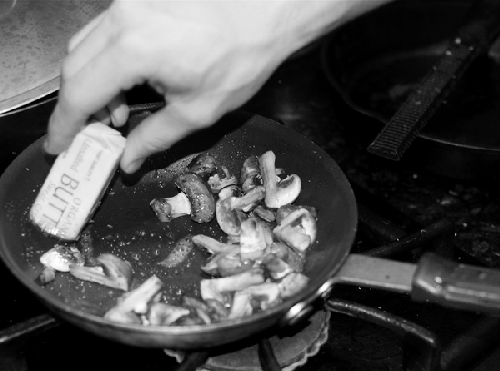You’ll have an easier time cooking as you learn
about more flavors and the ingredients that provide them. Take time to notice the odors in
the foods you are eating, taking note of smells that you don’t recognize. Next time you’re
eating out, order a dish you’re not familiar with and try to guess its ingredients. If
you’re eating with a friend who doesn’t mind sharing, play a guessing game with your dinner
companion to see if you can identify the tastes and flavors in both dishes.If you’re stumped, don’t be shy to ask the staff. I remember being served a roasted red
pepper soup and being completely stumped as to what provided the body (thickness) of the
soup. Five minutes later, I found myself sitting across from the chef, who had brought me
the kitchen’s working copy of the recipe and told me the real secret of the recipe (Armenian
sweet red pepper paste). I learned not just about a new type of flavor that day, but also
about a new technique (toasted French bread puréed into the soup—an old, old trick to
thicken soups) and the location of a great Armenian grocery store.
Another way to learn new flavors is to play “culinary mystery ingredient.” Next time
you’re at the grocery store, buy one thing you’ve never cooked with before. For
“intermediate players,” pick up something you’re familiar with but have no idea how to cook.
And if you’ve progressed to the “advanced” level, choose something that you don’t recognize
at all. You’d be surprised at how many foods can be unfamiliar in their ingredient form, but
once cooked into a meal are familiar, maybe even downright commonplace. Yucca roots? Try
making yucca fries. Lemongrass, kaffir lime leaves? Try making tom yum soup. With the
thousands of items available in your average American grocery store, you should be able to
find something new to inspire you.
If you’re just now learning your way around the kitchen and aren’t yet familiar with
that many recipes, think about the ingredients that go into dishes you like. If you like
peanut butter and jelly sandwiches (and what self-respecting geek wouldn’t?), it’s not too
far a leap to imagine a grilled chicken skewer coated with a sweet jelly and sprinkled with
toasted peanuts. Or take another geek favorite: pizza. Maybe you like it topped with
artichokes, feta, dried tomatoes, and anchovies. You could experiment by taking those
toppings and adapting them for use in a pasta dish or as toppings on bread as an appetizer.
Serving this to guests? Coat the bread with olive oil, toast it, and you’ve got
bruschetta.
If items A, B, and C go together in one dish; and another dish uses B, C, and D; then A
might work in the second dish as well. Transitive relationships aren’t guaranteed to work,
but they’re a great place to start. Say you like guacamole and know that it commonly
contains avocado, garlic, onion, lime juice, and cilantro. When tossing together a salad
that has similar ingredients—say, tomato, avocado slices, and onion—it’s reasonable to guess
that some coarsely chopped cilantro will work well in it, and maybe even some crushed garlic
in a vinegar/oil dressing.

Ingredients that commonly show up with chicken (left) and chocolate
(right). This screenshot is from a visualization I did that displays related
ingredients by building a co-occurrence map of ingredients in recipes—in essence,
generating a network graph of the ingredients.

Like tastes in
music, tastes in food aren’t completely transitive. At the extreme, what one culture values
often proves to be jarring to another culture. Traditional Chinese music uses a pentatonic
scale (five notes per octave); European music uses a heptatonic (seven-note) scale. This is
why some Chinese music sounds just plain odd to western listeners. The same is true in
flavors: combinations used in one culture are invariably different from those used in
another. When the difference is too great, the tastes lack appeal. Take cheese: plenty of
European and American foods use it (who would the French be without cheese? how could
lasagna be lasagna without it?), but the Chinese barely recognize it as
a food.
Gourmet Magazine ran a good article (August, 2005) about three
acclaimed Sichuanese chefs from China eating at one of the absolute top restaurants in the
United States. They didn’t “get” the food at all. The flavors just didn’t strike chords in
the ranges for which the chefs had formed any appreciation. This isn’t to say that the
flavors that excite you will be unstimulating for the friends that you cook for, unless
you’re cooking for a bunch of world-famous Chinese chefs. But there will be some differences
between your tastes and experiences and those of your guests, so don’t be surprised if a
combination of flavors tastes great to you and merely okay to your eating companions.
Another
method for finding ingredients to experiment with is to run a simple online search with a
list of ingredients you already have in the dish. If you’re making an improvised stew (i.e.,
following no recipe) and have tomatoes, onions, and lamb but aren’t sure what foods and
spices might round out the flavors, run the existing ingredients in an online search and see
what the Internet says. Just scanning the titles of pages found can be enough (in this case,
coriander, potatoes, and chili powder).
When experimenting, you might find it easier to test a new flavor in a small portion set
aside in a separate bowl. Cooking has no “undo,” so if you’re not sure that the chili power
will work, put a few spoons of the stew in a bowl along with a pinch of the spices and taste
that. That way, if it turns out yucky, you still have an unadulterated pot of stew to try
something else with.
Similarity is also a good gauge of compatibility. If a recipe calls for A, but B is
extremely similar, try using B instead and see if it works. Kale and chard are both hardy
green leaves that can be substituted for each other in many dishes. Likewise, Provolone and
mozzarella cheese both have mild flavor and share similar melting properties, so using one
in place of the other in foods like omelets makes sense. I’m not suggesting that like foods
are always interchangeable. They each have their distinct flavors, and if you attempt to
recreate a traditional dish with substitutions, you won’t faithfully reproduce the original.
But if your goal is to make an enjoyable dish, experimenting with similar ingredients is a
great way to see where things line up and where they diverge.
One easy place to start experimenting, especially if you’re at the pasta sauce and
spaghetti phase (ah, those were the days!), is to take whatever it is you’re doing now and
start making minor changes. If one of your standard dinners is store-bought pasta sauce over
spaghetti (and there’s nothing wrong with this; it’s easy, yummy, and satisfying), toss in
some additional vegetables next time. Take a nonstick frying pan, put in a tablespoon or two
of olive oil, chop up an onion, and sauté the onion for a while, until it tastes good. Think
about the taste. Does it need salt? Onion and olive oil by itself, while good, is a little
flat. So, toss in a pinch of salt. Now, take the jar of pasta sauce, heat it up in that same
frying pan, and toss in your spaghetti, just as before. “Spruced-up pasta sauce” is easy and
tastes better than the original (unless you burned the onions, in which case, try
again!).
Note:
Here’s an example of how to extend pasta sauce, courtesy of one of my readers: Try
mixing in a can of quality tuna and chopped olives. Microwave a few ounces of pancetta
until crispy, and then crumble it into the sauce.
Next, begin to expand your
flavor repertoire. The next time you make the dish, try something other than an onion. At
the grocery store, take a look at other veggies and ponder whether they might go in that
pasta sauce equally well. Zucchini? Squash? Mushrooms? They all sound good to me. One
sure-fire way of guessing is by peeking at the ingredient list on your jar of pasta sauce.
If it includes mushrooms and oregano, you know adding more mushrooms won’t cause an
unpleasant flavor. The key is to try varying these things one at a time, starting slowly and
building up various bits of information one variable at a time. It’s just like writing and
then debugging code: instead of making a whole bunch of changes, try one thing at a time. As
you get more comfortable, you can work for longer intervals before testing your
logic.
If you fold back the wrapper on a stick of butter, you can butter the pan
with it directly. It’s not as elegant as slicing off a pat and dropping it into the
pan, but it does save fetching and washing another utensil. Make sure to fold the
paper back over the end when storing, so the butter is wrapped when you put it back in
the fridge. As an experiment, figure out if “crowding” the mushrooms matters.
Conventional wisdom says that overcrowding the pan will cause the mushrooms not to
taste as good, but is this really true?

If you’re already a master of the “spruced-up pasta sauce method,” try experimenting
with what the French call mother sauces. The French chef Marie-Antonin
Carême began this classification scheme in the 17th century with a handful of sauces from
which virtually all traditional French sauces are derived. Both Béchamel and velouté sauces
are fast to make and can carry a lot of flavors.
Beyond picking harmonious flavors, you should also consider how they blend together (the
“loudness” of the notes). Good cooking is very much about balance. One of the most important
corrections you can make is to adjust the balance of tastes and smells to where you think
the dish tastes ideal. Lean in and smell the dish. Take a taste. Then ask yourself: what
would make this dish better? Does it need more salt? If it’s dull or flat, would adding a
sour note (lemon or lime juice) add some brightness? Is it too heavy on one of the tastes?
Some pasta sauces, for example, can benefit from a splash of balsamic vinegar (sour) to help
balance the sweetness brought by tomatoes. Chocolate chip cookies can be improved with a bit
of salt to help balance the sweetness from sugar and slight bitterness from cocoa.
If you’re following a recipe closely, approach your
tweaking cautiously, being sure not to add too much of a taste modifier such as salt or
lemon juice, because it is nearly impossible to remove it. Add only a small amount at the
beginning, and adjust the taste at the end of cooking by adding a little more at a time
until it tastes balanced.
If you do add too much seasoning, you can make minor adjustments of other taste
sensations to partially mask overzealous seasoning. If, however, you’ve added too much of
something, your best bet is to dilute the dish to reduce the seasoning’s concentration.
Contrary to folk wisdom, adding potato does nothing to reduce saltiness (how could it?
evaporation?), but might “work” for the same reasons that adding more broth does (dilution).
You’re better off just removing some of the too-salty liquid and adding more unsalted
liquid. If your dish is too sweet, you can adjust it by adding spicy ingredients.
Note:
Capsaicin is sugar and fat soluble, but not water soluble. This is why drinking milk
or consuming something fatty tames the mouth, while drinking water doesn’t help. If a dish
is too hot, add either something with sugars or fats to reduce the heat.
Think about what tastes are missing, and add one of the following seasonings to adjust
the taste.
|
To increase:
|
Bitter
|
Sour
|
Umami
|
Sweet
|
Salty
|
|---|
|
Add...
|
Cocktail bitters
Quinine powder
Tonic water
Cocoa
|
Lemon juice
Vinegar
Verjuice (verjus) or dry wine
|
Soy sauce
Fish sauce
Mushrooms
Kombu (seaweed)
MSG
|
Sugar
Honey
Sweet wines (sherry, Madeira)
Mirin
|
Salt
Umami-based ingredients (because they amplify salt perception)
|
As a general tenet when seasoning a dish, start slowly. You can always add more. You can
partially mask some tastes by increasing other tastes. If you do end up with one taste being
too dominant, try one of the following adjustments.
|
To counteract:
|
Bitter
|
Sour
|
Umami
|
Sweet
|
Salty
|
|---|
|
Add...
|
Increase saltiness or sweetness
|
Increase sweetness to mask
|
None known; try dilution
|
Increase sourness or heat (e.g., cayenne pepper) to mask
|
Increase sweetness (low concentrations) to mask
|
In a pan, melt 1 tablespoon / 14g butter over
medium heat. Stir in 1 tablespoon / 8g flour and continue stirring, making sure to combine
the flour and butter thoroughly, cooking for several minutes until the mixture begins to
turn a blond to light brown color (this butter-flour combination is called a
roux). Add 1 cup / 256g milk, increase the heat to medium-high, and
stir continuously until the mixture has thickened. Traditional additions include salt, pepper, and nutmeg. Try adding dried thyme, or
preheating the milk with bay leaves. If you’re anti-butter, you can use a half butter/half
oil mixture. This sauce can be “subclassed” into other sauces. After making the roux and adding the
milk, try the following instances: Mornay sauce (a.k.a. cheese sauce) Béchamel sauce with equal parts of Gruyère and Parmesan added. If you’re not a
stickler for tradition, almost any cheese that melts well will work. Bayou sauce Béchamel sauce that’s had the roux cooked until it reaches a dark brown color.
Commonly used in Louisiana-style Cajun cooking, in which onions, garlic, and Creole
seasonings are also added. Mustard sauce Béchamel sauce with mustard seed or a spoonful of mustard (try one with whole seeds in
it). Mustard sauce can be further subclassed with the addition of cheddar cheese and
Worcestershire sauce. Or, try sautéing some diced onions in the butter while making the
roux and adding mustard at the end for a mustard-onion sauce. |
Start like you’re making Béchamel: create a blond roux by melting 1 tablespoon / 14g
of butter in a pan over low heat. Stir in 1 tablespoon / 8g of flour and wait for the
flour to cook, but not so much that it browns (hence the term blond
roux). Add 1 cup / 256g of chicken stock or other light stock (one that uses
raw bones instead of roasted bones) and cook until thickened. You can make derivative sauces by adding various ingredients. Here are a few
suggestions. Note the absence of specific measurements; use this as an exercise to take a
guess and adjust the flavors to suit what you like: Albufera sauce Lemon juice, egg yolk, cream (try on chicken or asparagus) Bercy sauce Shallots, white wine, lemon juice, parsley (try on fish) Poulette sauce Mushrooms, parsley, lemon juice (try on chicken) Aurora sauce Tomato purée; roughly 1 part tomato to 4 parts velouté, plus butter to taste (try on
ravioli) Hungarian sauce Onion (diced and sautéed), paprika, white wine (try on meats) Venetian sauce Tarragon, shallots, chervil (try on mild fishes) |
Make either a
bayou sauce or mustard sauce per previous instructions, playing with the amount of onions
and seasoning. Select a mild fish, such as cod or halibut. Season with a light amount of salt and
pepper and transfer to a heated grill. Cook for about 5 minutes, flip, and cook until
flaky, about another 5 minutes. Place on serving plate and spoon sauce on top. (Try
serving this with simple steamed vegetables!) |
Here’s a quick experiment: try making two batches of Aurora sauce, one with 1 cup /
240 ml of light cream and the second with 1 cup / 240 ml of chicken stock. Add ¼ cup / 60
ml of either tomato sauce or puréed tomatoes to each and stir to combine. (If you’re
cutting corners and cooking for yourself, you can use ketchup instead of tomato
purée.) What do the two sauces remind you of? Try using the cream-based sauce (sometimes
called a pink sauce) on top of ravioli. And the stock-based sauce? Toss in some carrots,
celery, beans, and pasta, and you’ve got the beginning of a minestrone soup. |
Start with a double batch of Béchamel sauce. Add and slowly stir until melted:
1 cup (100g) grated mozzarella
1 cup (100g) grated cheddar cheese
In a separate pot, bring salted water to a rolling boil and cook ½ cup / 250g pasta.
Use a small pasta, such as elbow, fusilli, or penne—something that the sauce can cling to.
Test for doneness by tasting a piece of the pasta. When ready, strain and transfer to pan
with cheese sauce. Stir to combine.
You can stop here for a basic Mac ‘n Cheese, or spruce it up by mixing in:
¼ cup (60g) sautéed onions
2 slices (15g) bacon, cooked and chopped into
pieces
A pinch of cayenne pepper
Transfer to a baking pan or individual bowls, sprinkle with bread crumbs and cheese,
and broil under medium heat for 2 to 3 minutes, until bread and cheese begin to
brown.
Notes
You can add more milk to the cheese sauce to make it
thinner.
To make your own bread crumbs, you can drop a slice of day-old or
toasted bread into a food processor or blender and pulse it. Or, use a knife and
chop it up into small pieces.